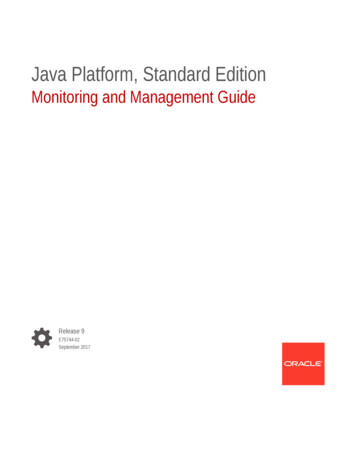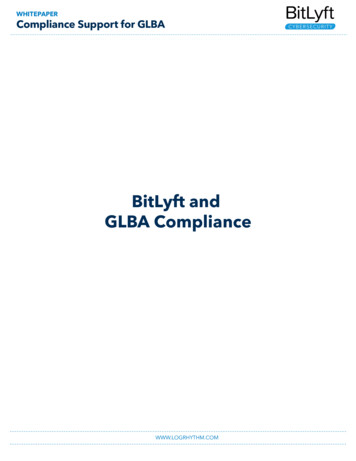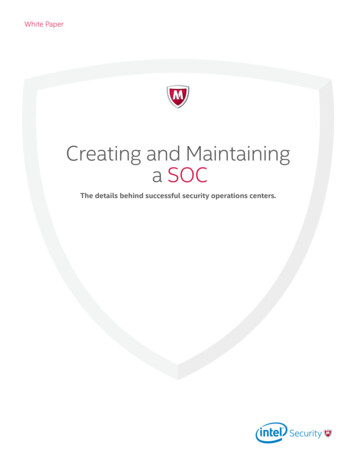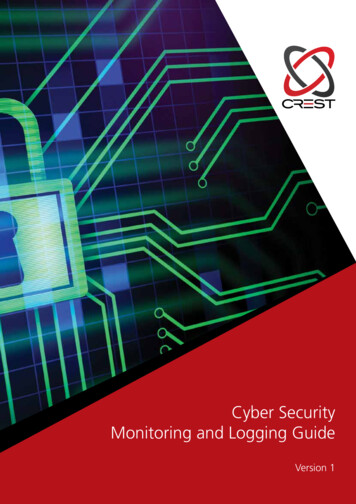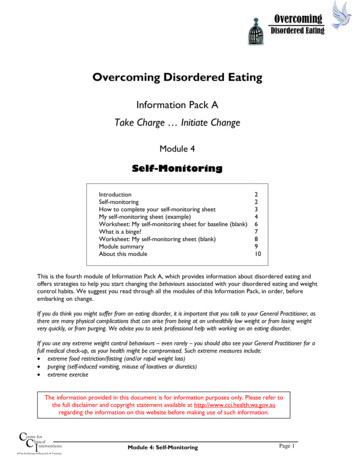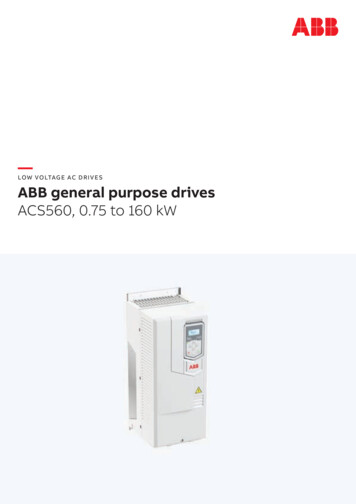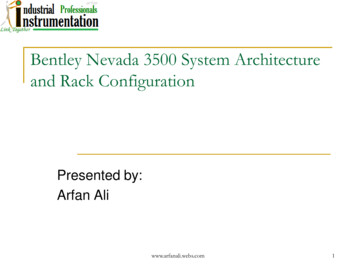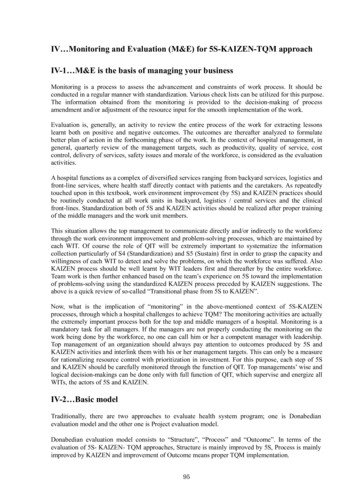
Transcription
IV Monitoring and Evaluation (M&E) for 5S-KAIZEN-TQM approachIV-1 M&E is the basis of managing your businessMonitoring is a process to assess the advancement and constraints of work process. It should beconducted in a regular manner with standardization. Various check lists can be utilized for this purpose.The information obtained from the monitoring is provided to the decision-making of processamendment and/or adjustment of the resource input for the smooth implementation of the work.Evaluation is, generally, an activity to review the entire process of the work for extracting lessonslearnt both on positive and negative outcomes. The outcomes are thereafter analyzed to formulatebetter plan of action in the forthcoming phase of the work. In the context of hospital management, ingeneral, quarterly review of the management targets, such as productivity, quality of service, costcontrol, delivery of services, safety issues and morale of the workforce, is considered as the evaluationactivities.A hospital functions as a complex of diversified services ranging from backyard services, logistics andfront-line services, where health staff directly contact with patients and the caretakers. As repeatedlytouched upon in this textbook, work environment improvement (by 5S) and KAIZEN practices shouldbe routinely conducted at all work units in backyard, logistics / central services and the clinicalfront-lines. Standardization both of 5S and KAIZEN activities should be realized after proper trainingof the middle managers and the work unit members.This situation allows the top management to communicate directly and/or indirectly to the workforcethrough the work environment improvement and problem-solving processes, which are maintained byeach WIT. Of course the role of QIT will be extremely important to systematize the informationcollection particularly of S4 (Standardization) and S5 (Sustain) first in order to grasp the capacity andwillingness of each WIT to detect and solve the problems, on which the workforce was suffered. AlsoKAIZEN process should be well learnt by WIT leaders first and thereafter by the entire workforce.Team work is then further enhanced based on the team’s experience on 5S toward the implementationof problems-solving using the standardized KAIZEN process preceded by KAIZEN suggestions. Theabove is a quick review of so-called “Transitional phase from 5S to KAIZEN”.Now, what is the implication of “monitoring” in the above-mentioned context of 5S-KAIZENprocesses, through which a hospital challenges to achieve TQM? The monitoring activities are actuallythe extremely important process both for the top and middle managers of a hospital. Monitoring is amandatory task for all managers. If the managers are not properly conducting the monitoring on thework being done by the workforce, no one can call him or her a competent manager with leadership.Top management of an organization should always pay attention to outcomes produced by 5S andKAIZEN activities and interlink them with his or her management targets. This can only be a measurefor rationalizing resource control with prioritization in investment. For this purpose, each step of 5Sand KAIZEN should be carefully monitored through the function of QIT. Top managements’ wise andlogical decision-makings can be done only with full function of QIT, which supervise and energize allWITs, the actors of 5S and KAIZEN.IV-2 Basic modelTraditionally, there are two approaches to evaluate health system program; one is Donabedianevaluation model and the other one is Project evaluation model.Donabedian evaluation model consists to “Structure”, “Process” and “Outcome”. In terms of theevaluation of 5S- KAIZEN- TQM approaches, Structure is mainly improved by 5S, Process is mainlyimproved by KAIZEN and improvement of Outcome means proper TQM implementation.95
5S-KAIZEN-TQM approach and y & ovement1.5yrs5SPhysicalConditionBuilding PositiveMind SetFigure 4-1: 5S-KAIZEN-TQM approach and M&EProject evaluation model consists to “Target”, “Objective” and “Goal” in the logically designated plan.One of the most common planning frames is called “Logical framework”. There is “means and end”relationship among them. In terms of the evaluation of 5S- KAIZEN- TQM approaches, ProjectPurpose is same as purpose of 5S, KAIZEN and TQM, Target is same as target area of 5S, KAIZENand TQM activities and Overall Goal means system of continuous 5S, KAIZEN and TQM activities.Logical Framework(Project Design Matrix)Project NameDuration:Target AreaTarget groupVer. No.DateNarrative Summary Objectively Means ofVerifiable VerificationIndicatorsOverall GoalImportantAssumptionsProject PurposeOutputsActivitiesInputsPreconditionsFigure 4-2: Logical Framework (Project Design Matrix)96
IV-3 Evaluation FrameworkEvaluation is assessing and judging the value of work of an organization. Its main purpose is to helpan organization reflect on what it is trying to achieve, how far it is succeeding and identifying therequired gaps. Generally, there are two dimension of the evaluation, formative and summative.Table 4-1: Two neSummativeReflect processHelp ImprovementSelf or AdvisorCan be qualitativeBaseline data NecessaryCheck AchievementProbe ImpactThird partyPreferably quantitative objectiveBaseline data essentialFormative evaluation is a process of ongoing feedback on performance. The purposes are to identifyaspects of performance that need to improve and to offer corrective suggestions. Summativeevaluation is a process of identifying larger patterns and trends in performance and judging thesesummary statements against criteria to obtain performance ratings.IV-4 Objectives of monitoring and evaluation for 5S-KAIZEN-TQMapproachAs mentioned above, the objective of the monitoring and evaluation is to minimize the gap betweendesired and actual status of the progress and / or performance of the project. For the health sector, themonitoring findings mainly describe the relevance of the process for service provision and theevaluation findings prove a real impact for ensuring the quality and safety for the hospital.The evaluation on the program of Quality Improvement of Health Services by 5S-KAIZEN-TQM is tobe viewed in the following three aspects:To evaluate the progress of 5S-KAIZEN-TQM in hospitalsFirstly, it should be identified that the unique feature of the 5S accomplishment in the workplace ofthe hospital is to make initiation of the KAIZEN process.Secondary, it should be evaluated that the improvement of the output, such as productivity, quality,cost control, safety, service delivery and morale of the staff, is accomplished though KAIZENactivities.Finally, it should be reviewed the improvement of the outcome, such as clinical performance,employee satisfaction, patient satisfaction and the contribution for National Health Plan, is monitoredtoward the center of excellence with TQM.To disseminate 5S-KAIZEN-TQM policy through the regulatory authority of that countryMonitoring and evaluation performances of the implementing authority especially Ministry of Healthand pilot hospitals are mandatory for accommodating the relevance, efficiency and effectiveness of5S-KAIZEN-TQM approach. The evaluation findings should be a policy input for the Ministry ofHealth for adopting right policy direction through strategic plan and guidelines and budget allocationfor implementing the quality improvement of Health Services through 5S-KAIZEN-TQM.To organize supporting system of 5S-KAIZEN-TQM at hospitalsSupporting system should be the part of evaluation. To encourage the activities in the field not tocriticize /discourage their ongoing activities and to input necessary knowledge and skills are the mostimportant roles of the supporting body. Mapping out whole supporting system and what is thefunction of each and how often what they do act and what expect to do. Supporting97
structure-instruction, information delivery of the field should be provided in right way and better tochalk out the time table/schedule of the whole supporting system.IV-5 Target of Monitoring and evaluation for 5S-KAIZEN-TQMapproach(1) 5SThe target of 5S is Work Environment Improvement (WEI). Taking photo before the implementationand after the implementation is basis for the monitoring and evaluation. Since it is mainly physicalimprovement, changing better situation is easy to identify visually. The implementation of minimumrequirement in 5S is confirmed by check sheets at first, and the performance or output by 5S is alsoconfirmed by check sheet and the other indicators if possible.(2) KAIZENThe target of KAIZEN is Output of the hospital though changing working process by KAIZEN, suchas Productivity, Quality, Safety, Cost control, service Delivery and Morale of the staff. Also theKAIZEN process should be confirmed to clarify relationship between the improvement of Output andKAIZEN activities, such as WIT performance and empowerment of the staff.(3) TQMThe target of TQM is Outcome by the hospital such as Clinical Indicators, Employee satisfaction andPatient satisfaction. If the hospital has the other tasks such as research, education and policydeployment, there is also the target of TQM.IV-6 FeedbackThe result of a process activity, output or outcome as evaluative response should be shared among thestakeholders. Periodical Meetings and 5S festivals are good opportunity to share the result anddrawing the results on the graphs and tables and posting on the notice boards are effective. Thecontents of the results consist not only the data and negative sounds but also good practice,recommendation and lessons learned.The monitoring and evaluation should be navigators toward further improvement by5S-KAIZEN-TQM approach.IV-7 Interaction between 5S-KAIZEN-TQM implementation and M&EThe figure 4-3 shows the phases of 5S-CQI (KAIZEN)-TQM implementation and how the M & Ecomes in. There are two things depicted here, which need to sit at the back of the mind of healthworkers; firstly, M & E is a continuous process; and secondly, 5S activities are never onetimeimplementation, they should be done on daily basis.98
nInput-Fund-Health ialPreparatoryphaseProcessTraining on5S-KAIZENTQMOutputIncreased # ofinternal andexternalsatisfactionOutcomeIncreased %internal andexternalsatisfactionImpactTotal QualityImprovementPractice of 5SKAIZENTQM activitiesin a hospitalIntroductionphaseImplementation phaseMaintenance phaseFigure 4-3: Interaction between5S-KAIZEN-TQM and M&EMost important input for 5S-KAIZEN-TQM activities is health workers that practice5S-KAIZEN-TQM activities. 5S starts from training and education of health workers. Thus, trainersand teaching materials are considered as input.After “Input” resources are there, it is necessary to train health workers. Then, practice5S-KAIZEN-TQM activities in health facility. Due to the practice of 5S-KAIZEN-TQM activities, weexpect the improvement of working environment and quality of services. Therefore, our expect outputare increase the level of internal and external satisfaction through 5S-KAIZEN-TQM activities. Thencontinuation of the activities will make the satisfaction of both internal and external clients higher,and finally possible to establish total quality managed health facility as the impact of5S-KAIZEN-TQM activities. To achieve this set goal, regular monitoring, mentoring and recognitionof health workers, and evaluation of 5S-KAIZEN-TQM activities is essential.IV-8 Monitoring and Evaluation of 5S-KAIZEN-TQM approachesIn the actual setting in developing countries, different levels of monitoring and evaluation activitiescould be conducted to ensure implementation of 5S-KAIZEN-TQM activities. Those levels are;(1) National and local government levelExternal monitoring and evaluation of 5S-KAIZEN-TQM activities to health facilities are conduct atthis level.(2) Health facility management levelInternal monitoring and evaluation of 5S-KAIZEN-TQM activities to departments/sections /Units areconduct at this level.(3) Health facility section/unit levelDaily monitoring and periodical self-evaluation of 5S-KAIZEN-TQM activities are carried out at thislevelAs mentioned before, it is very important to consider integration of existing health systems and M&Emechanism.99
For example, United Republic of Tanzania introduced 5S-KAIZEN-TQM approaches into publichospitals at national, regional and district level. Currently, Ministry of Health and Social Welfare isconducting all external evaluation of 5S-KAIZEN-TQM activities, so called “Consultation visit”.However, number of hospitals implementing 5S-KAIZEN-TQM activities, increases, it is difficult tomanage all “Consultation visit”. Therefore, it is trying to match with existing supportive supervisionmechanism and “Consultation visit” at regional level, so that Regional Health Management Team(RHMT) can conduct “Consultation visit” to their own Regional Referral Hospital. Integration ofM&E mechanism will improve sustainability, reduce costs and minimize other resources for M&E of5S-KAIZEN-TQM activities. Supportive SupervisionExternal M&E Progress Report MeetingInternal M&ESelf M&E Quarterly monitoring,mentoring of 5S-KAIZENactivities Bi-annual internal evaluation Monitoring of Daily 5S activities Monitoring of KAIZEN processstep by stepFigure 4-4: Different levels of M&E activities for 5S-KAIZEN-TQMTherefore, it is very important to study about exiting M&E mechanism, and consider integration orharmonization of those M&E activities, tools and indicators with M&E activities of5S-KAIZEN-TQM approaches.External monitoring and evaluationMinistry of Health or local government health authority is the responsible of external M&E activities.At the beginning of national rollout of 5S-KAIZEN-TQM approaches, Ministry of Health needs toorganize and conduct external M&E activities to the health facilities. However, after rollout of theapproaches, local government health authority needs to take over the M&E activities under thedecentralization movement.As an example, Tanzania Ministry of Health and Social Welfare, Department of Health QualityAssurance (MoHSW-DHQA) organizes “Consultation visits” to provide technical support andevaluate 5S-KAIZEN-TQM activities every 6 months. However, number of 5S implementinghospitals is increasing and difficult to monitor and evaluate 5S activities in many hospitals. Therefore,MoHSW-DHQA started to involve Regional Health Management Team (RHMT) and planning tohand over M&E activities for 5S-KAIZEN-TQM to regional level.Another activity is called “Progress Report Meeting”. The meeting to receive reports on progress of5S-KAIZEN approaches implementation every 6 months. All 5S-KAIZEN implementing hospitals areinvited to present their progress of activities. In the past, power point presentation, lectures, discussionand practice methodologies were used for training and rolling out of the approach.These kinds of M&E activities are very important to organize and continue by Ministry of Health orlocal government health authority until 5S-KAIZEN-TQM activities become a culture of hospitals.Unfortunately, many public health facilities and staff working in the facilities used to get “order” from100
higher authority or top management. However, 5S-KAIZEN-TQM approaches need to developtwo-way communication from “top to bottom”, and “bottom to top” This two-way communicationimproves openness in the facility and possible to see and hear what is happening on the ground.Internal Monitoring and Evaluation by Quality Improvement Team (QIT)QIT has responsibility of conducting monitoring and evaluation of 5S-KAIZEN-TQM activitieswithin health facility. QIT monitor and evaluate their own performance and visit sections/departmentsperiodically that are practicing 5S-KAIZEN-TQM activities. Visit sections/departments and providetechnical advices, through coaching and mentoring, to Work Improvement Teams (WITs) are veryimportant to know the progress of 5S-KAIZEN-TQM activities and find problem(s). During themonitoring of 5S-KAIZEN-TQM activities at section or department level, QIT needs to observe thefollowing issues; Performance of WITs-Leadership,-Composition of WIT,-Record keeping (pictures, minutes of meeting etc.)-Training of staff-Way of communication (reporting, regular meeting etc.) Progress of Sort, Set, Shine, Standardize and Sustain activities Progress of KAIZEN Process, if any KAIZEN approach is practiced Staff attitudePoints and areas to evaluate 5S-KAIZEN-TQM activities are same as monitoring. However, it isimportant to use evaluation sheet with proper evaluation scale (see VIII-1, VIII-2: 5S-KAIZEN M&Esheet)Self-monitoring by Work Improvement Team (WIT)Work Improvement Team (WIT) has responsibility to monitor day-to-day 5S and KAIZEN activitiespracticed within their work place. Progress of 5S and process of KAIZEN activities must bedocumented and share the results within the department/sections. The WIT will also communicate theresults to QIT; and WIT should develop their own checklist for 5S-KAIZEN activities.IV-9 Tools used for monitoring and evaluation of 5S-KAIZEN-TQMTo ensure effective implementation of the 5S-KAIZEN-TQM approaches, useful tools weredeveloped and tested in many countries. The tools are as follows: Digital camera5S-KAIZEN-TQM Monitoring and Evaluation sheet (VIII-1, VIII-2)5S-KAIZEN-TQM Monitoring and Evaluation calculatorKAIZEN Process Checklist (VIII-3)5S Activity Good Practice Sheet (Figure 4-7)QIT interview sheet (VIII-4);In addition, implementation plan develop in KAIZEN Process Step 5, Standardization plan develop inKAIZEN Process Step 7 are also important for monitoring of KAIZEN activities.M&E tools can be developed only for 5S-KAIZEN-TQM activities. However, it is important to checkother existing M&E tools that used in another program or regular supportive supervision in healthsector. Look at possibility of integration of 5S-KAIZEN-TQM components into those tools toimprove sustainability of M&E activities for 5S-KAIZEN-TQM.101
IV-10 Visualization of M&E results and Record keepingAfter completion of M&E activities, it is better visualize M&E results for easy understand and sharingresults within your health facility or sharing with others. There are many ways to visualize M&E resultssuch as photo taking, graphs, charts etc.As mentioned in the above, photo taking (pictorial records) are good example of visualization. Phototaking is very good visualization for 5S activities. Pictures of before 5S, during the process, and after 5Sneed to be recorded. It is very powerful evidence of changes and improvement of working environment inhealth facility.Before 5SBefore 5SAfter 5SProcessFigure 4-5: Samples of pictorial record102After 5S
Another good example of visualization is Radar chart created from 5S-KAIZEN M&E sheet. Thisradar chart with comparison of previous evaluation helps QIT and external evaluators to understandimprovement or fall back of 5S-KAIZEN-TQM activities.Figure 4-6: Sample of radar chart with comparisonSimilar to pictorial record, “Good Practice Sheet” is useful for both pictorial and 5S activity recordkeeping. The sheet contain information on where and who practiced, what was the problems and howthe problems was solved with what type of inputs were used with pictures of before and after 5Sactivities.103
Figure 4-7: Sample of good practice sheetQuality Improvement Team is the responsible unit to keep all M&E records with proper arrangementof information. Proper record keeping is very important to avoid repetition or rework which leads toreduce workload of QIT.104
Figure 4-2: Level of M&E activitiesTypeImplementerFrequencyM&EactivitiesM&E throughM&E ToolExternalM&EMinistry of HealthLocal ationSupportiveSupervisionProgress ReportMeetingStandardized M&EsheetDigital QuarterlyMonitoring,Mentoring,EvaluationVisiting sections anddepartmentsQIT-WIT meetingStandardized M&EsheetDigital ervation andWIT meetingInternal ChecklistActivity planIV-11 Other tools for Monitoring and EvaluationMonitoring and Evaluation are opportunities for 5S or KAIZEN activities to examine how well it isimplementing its activities towards results and to formulate lessons learned. Our broad goal should bedefined which reflects overall aim of the evaluation. There are many methods for evaluation.According to for 5S-KAIZEN-TQM approach, we also recommend three methods for monitoring andevaluating with the qualitative point of view; Time survey, Employee satisfaction survey and Patientsatisfaction survey.(1) Time surveyThrough 5S –KAIZEN- TQM activities, there is a lot of improvements in the hospital. However, someimprovements are invisible and hard to confirm the achievement in the routine works in the hospital.The time survey is good tool to describe the process improvement easily and simple tool to measurethe working process by the hospital staff. The hospital staff also is able to identity whether her / hiswork is efficient or not.We hope the hospital to implement the time survey periodically to make sure the level ofimprovement of your hospital and to benchmark the performance of the improvement to the otherhospitals. The examples are shown as following occasions.Time survey for “Waiting time”i) ReceptionThe receptionist gives a patient who just arrived at the reception the paper which was written thearrival time. The paper will received to hospital staff at the consultation room when the patient willcome to the consultation room. The hospital staff writes the time of collection on the paper andcalculates how much time was spent from arriving to the hospital to taking consultation.ii) Laboratory testAt the consultation room, laboratory test request paper is issued with the issuing time. The laboratorytechnologist writes the time of issuing the result of laboratory test on the paper and gives the patientthe result paper with request paper.The request paper and result paper are collected at consultation room when the patient come again tothe consultation room and the hospital staff calculates how much time was spent from test request toreceiving the test result and consultation again.105
iii) PaymentThe account staff gives a patient who just arrived at the accounting section to pay money the paperwhich was written the arrival time. The paper will be collected to hospital staff when the patient willpay money. The hospital staff writes the time of collection on the paper and calculates how much timewas spent from arriving to the accounting section to paying money.2) Time survey for “Work hours”i) Patient recordThe surveyor measures the time by stop watch from ordering to the patient record room to taking theproper patient record. (Try more than ten times and calculate average time)ii) PharmacyThe surveyor measures the time by stop watch from ordering to the pharmacy to taking the propermedicines. (Try more than ten times and calculate average time)iii) Central Sterilize and Supply Department (CSSD)After the sterilization, the surveyor measures the time by stop watch from starting packing theoperation tools to completion of the packing. (Try more than ten times and calculate average time)iv) Linen supplyThe surveyor asks to the line staff to drawing bar-chats regarding the process and times of line supplysuch as collection of dirty linen, laundry, iron, setting on the shelves.(2) Employee satisfaction surveyInitial target of 5S-KAZIEN-TQM approach is to change the mindset of the employees throughproviding the appropriate environment for professional works of medical and non-medical staff. Themost useful indicator to justify the changing mind set is degree of the satisfaction of the employees interms of non-monetary incentives. The employ satisfaction survey deals with workplace issues, suchas benefit, commitment to work, amenity, conformability, effective communication and so on. And thesurvey helps paint a portrait of their attitudes, complain and suggestions.There are several types of template of employee satisfaction survey (also called job satisfactionsurvey). You can choose suitable one for your occasion or develop yourself based on the templates ifyou need not issues the result in academic fields as the evidence of the effectiveness of5S-KAIZEN-TQM approach.(3) Patient satisfaction surveyThe overall goal of 5S-KAIZEN TQM approach is to deliver necessary medical services timely withadequate cost as well as the aim of the hospital. To justify the performance toward the aim of thehospital objectively, the degree of appropriateness of the services might be evaluate by customers.One of the most important customers for the hospital is the patient because the hospital wasestablished for patients. The patient satisfaction survey also gives us the opportunity to know honestpatients’ feeling and to improve the hospital more and more if the survey has been implementedproperly and fed back to the QIT and WIT promptly.There are also several types of template of patient satisfaction survey (also called customersatisfaction survey). You can also choose suitable one for your occasion or develop yourself based onthe templates if you need not issues the result in academic fields as the evidence of the effectivenessof 5S-KAIZEN-TQM approach.106
IV-12 Recognition and CompetitionTo establish sustainable mechanism for implementation of 5S-KAIZEN-TQM activities in healthfacility, it is important to use two schemes of “Recognition” and “Competition”“Recognition” and “Competition” are often confused among people. These schemes are two differentthings. “Recognition” is a process to recognize achievement of implementers for certain level ofperformance towards to set standards or target. However, “Competition” is to compete level ofperformance among implementers, and rank them based on their performance.Usually,“Recognition” comes with certificate or recognition letter given to implementers when set standardsor target achieved. On the other and “Competition” comes with prize such as trophies, medals orplaque.Aims of introducing “Recognition” scheme into health facility are;To increase; motivation of health workers to continue good practices,To increase productivity and safety,To improve dialogue between management and health workers,To reactivate professionalism, strengthen teamwork.On the other hand, aims of introducing “Competition” scheme into health facility are;To energizing health workers,To increase performance,To enhancing creativity to come up with innovative ideas,To cultivate ownership and leadership and so on.Note that people often confuse recognition scheme with accreditation scheme. It is very important todifferentiate recognition scheme from accreditation scheme as recognition scheme has meaning ofappreciation on efforts made by implementers and recognized their performances. On the other hand,accreditation scheme is evaluate set standards of quality, and if those standards are not achieved,health facility could be punished.Introduction at Health Facility LevelsBased on the experiences from different health facility, it is recommended to introduce “Recognition”scheme first for effective and efficient rollout 5S activities. “Recognition” scheme needs to have clearcriteria to recognize achievement of implementers. The criteria for the scheme must be shared with allstaff working in health facility.The table below is the example of “Recognition” stage and its criteria. QIT should develop such tableand share with all sections and departments.Recognition stageStage 1Stage 2Stage 3Stage 4Stage 5Table 4-3: Sample of Criteria for Recognition schemeRecognition CriteriaWIT established and has OJT mechanism in the section.All WIT member has basic knowledge and skills on 5SSorting, Setting, and Shining activities continuouslyconductStandardization and Sustainable measures for 5Sactivities practicedAll WIT member has basic knowledge and skills onKAIZENSmall KAIZEN is practicedKAIZEN Process is used for solving problems in thesection107CertificatesCertificatesCertificates andannouncementCertificatesCertificates andannouncement
When the KAIZEN processes are known and used by health workers, introduction of “Competition”scheme will be effective. Annual KAIZEN competition can be organized with health facility.For example, each WIT select KAIZEN theme and work on the theme to improve services annually.WIT applies for Annual KAIZEN competition and presents their KAIZEN activities. QIT and healthfacility management evaluate their performance of KAIZEN activities in terms of; Selected KAIZEN theme and possible benefits for sections and the organizationKnowledge and technical skills for use KAIZEN processAchievement towards to the set targetPresentation skillTeam workDetailed marks of each applicant team are also opened to all staff. This will help WITs to improveweak areas and reduce envy of team awarded.Introduction at National LevelRecognition scheme at National level is difficult to manage. Central management of recognitionscheme costs a lot and takes lots of time to visit health facilities at different level. Therefore, it isrecommended Ministry of Health to develop guideline for recognition scheme, and local governmenthealth authority or hospital management team conduct recognition activities at respective field.Competition scheme can be applied at National level. Competition organized by Ministry of Health,and it is held annually to encourage hospital QITs to perform 5S-KAIZEN-TQM activities better forawards. However, it is
evaluation is a process of identifying larger patterns and trends in performance and judging these summary statements against criteria to obtain performance ratings. IV-4 Objectives of monitoring and evaluation for 5S-KAIZEN-TQM approach As mentioned above, the objective of the monitoring and evaluation is to minimize the gap between




